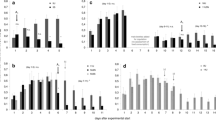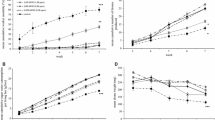Abstract
Effect of rearing and preconditioning temperature as well as type of pre-treatment on the susceptibility of Khapra Beetle Larvae (Trogoderma granarium Everts) to methyl bromide
The effect of two different rearing temperatures (25 and 28°C) on the susceptibility of Khapra Beetle Larvae to methyl bromide was investigated in the laboratory at 15 and 5°C. It was found that the exposure time needed for a given mortality is significantly longer for the larvae reared at 25°C than for the larvae reared at 28°C. However, these differences were abolished if the cultures of T. granarium bred at 25°C were transferred to 28°C and kept for 1 or 2 months at this temperature before the larvae were exposed to methyl bromide.
The effect of different types of pre-treatment on the susceptibility of the larvae was also tested at 0°C. Experimental results showed that the susceptibility of the larvae increased, when the Trogoderma cultures bred at 28°C were transferred directly to 20, 10 or 0°C and then kept for 1–2 months at one of these pre-conditioning temperatures before the larvae were exposed to the fumigant: at the test temperature.
No significant differences in the susceptibility of the larvae were found, when the cultures were transferred progressively from the rearing temperature (28°C), to 20, 15, 10, 5 and 0°C, then kept at each temperature for 2 days before the larvae were fumigated at 0°C. In this case a decrease in the susceptibility of the larvae was obtained if the pre-conditioning time at 0°C was extended to 8–10 days. Moreover, if the T. granarium cultures reared at 28°C were transferred to 25°C and kept for 1 month before the larvae were examined at 12° C. It was found that the larvae pre-conditioned at 25°C were less susceptible than those bred at 28°C. Anyhow, the same keeping-period at 20, 10 or 0°C caused an increase in the susceptibility of the larvae fumigated at the test temperature (12°C).
Similar content being viewed by others
Literaturverzeichnis
Bond, E. J., 1975: Control of insects with fumigants at low temperatures: response to methyl bromide over the ranges 25° to - 6,7°C. J. econ. Ent.68 (4), 539–542.
Bond, E. J.;Buckland, C. T., 1976: Control of insects with fumigants at low temperatures: toxicity of mixtures of methyl bromide and acrylonitrile to three species of insects. J. econ. Ent.69 (6), 725–727.
Busvine, J. R., 1971: A critical review of the techniques for testing insecticides. Commonwealth Institute of Entomology, London, 345 S.
Craufurd-Benson, H. J., 1938: An improved method for testing liquid contact insecticides in the laboratory. Bull. ent. Res.29, 41–56.
El-Lakwah, F., 1977: Untersuchungen zur Wirkung von Methylbromid besonders bei niedrigen Temperaturen gegen Khaprakäfer-Larven(Trogoderma granarium Everts. [Dermestidae, Coleoptera]). Anz. Schädlingskde., Pflanzenschutz, Umweltsdichutz50 (5), 68–73.
Fisher, R. W.;Hansell, R. C., 1964: Effect of pre- and post-treatment temperatures, age of deposit, and repellency on the toxicity of kelthane to the two-spotted mite (Tetranychus telarius L.) Acarina, Tetranychidae. Canad. Ent.96 (10), 1307–1312.
Munson, S. C., 1953: Some effects of storage at different temperatures on the resistance of the American Roach to DDT. J. econ. Ent.46 (1), 754–760.
Munson, S. C.;Padilla, G. M.;Weissmann, M. L., 1954: Insect lipids and insecticidal action. J. econ. Ent.47 (1), 578–587.
Sun, Y. P., 1947: Analysis of some important factors affecting the results of fumigation tests. Tech. Bull. Univ. Minn. agric. Exp. Sta. No. 177, 104 S.
Author information
Authors and Affiliations
Rights and permissions
About this article
Cite this article
El-Lakwah, F. Einfluß von Zuchttemperatur und Vorbehandlung auf die Giftempfindlichkeit von Khaprakäfer-Larven (Trogoderma granarium Everts) gegen Methylbromid. Anz. Schadlingskde., Pflanzenschutz, Umweltschutz 50, 180–183 (1977). https://doi.org/10.1007/BF02156726
Issue Date:
DOI: https://doi.org/10.1007/BF02156726




